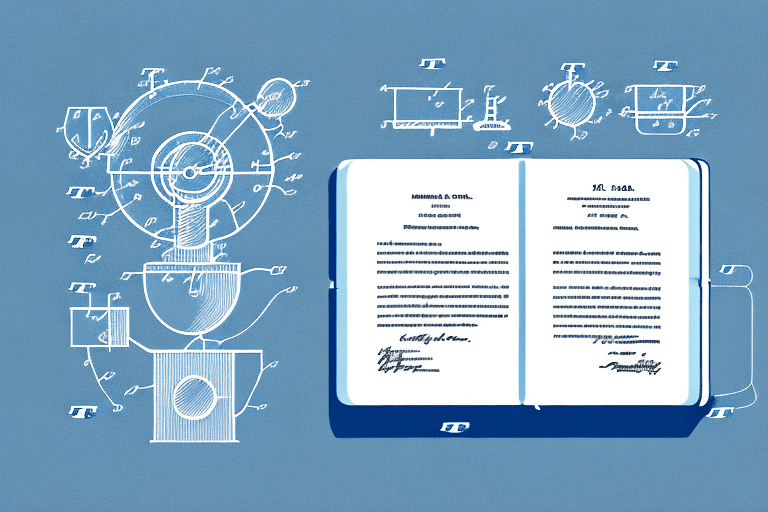In the world of patent law, understanding the preclusion doctrine is crucial. This doctrine plays a significant role in shaping how patents are granted, protected, and enforced. By delving into the depths of patents, exploring the intricacies of the Manual of Patent Examining Procedure (MPEP), and unraveling the significance of the Patent Bar, we can gain a comprehensive understanding of this important legal concept.
Understanding the Preclusion Doctrine
Before delving into the specifics of the preclusion doctrine, it is essential to grasp its definition and importance. The preclusion doctrine refers to the legal principle that once a court has decided an issue, it cannot be relitigated in subsequent cases between the same parties. This doctrine prevents unnecessary repetition of litigation and promotes judicial efficiency.
When it comes to patent law, the preclusion doctrine has far-reaching implications. It ensures consistency in the interpretation and application of patent laws, facilitating predictability and fairness in the patent system. By understanding how the preclusion doctrine operates within the realm of patent law, patent practitioners can navigate complex legal issues effectively.
Preclusion Doctrine in Patent Law
The preclusion doctrine intertwines with patent law in various ways. Firstly, it prevents the same issue from being litigated multiple times in separate patent infringement cases. Once a court has ruled on a particular patent issue, such as patent validity or infringement, that issue is considered “precluded” in subsequent lawsuits involving the same parties. This streamlines the litigation process and prevents inconsistent rulings.
Moreover, the preclusion doctrine also applies to administrative proceedings before the United States Patent and Trademark Office (USPTO). If a patent examiner has already decided on an issue, subsequent examiners cannot reexamine or challenge that determination in the same patent application or related applications. This ensures consistency in examination and prevents unnecessary reevaluation of previously decided matters.
Furthermore, the preclusion doctrine serves as a safeguard against forum shopping. Forum shopping refers to the practice of litigants seeking out the most favorable jurisdiction or court to hear their case. By precluding the relitigation of issues, the doctrine discourages parties from attempting to find a more favorable forum to obtain a different outcome. This promotes fairness and discourages the manipulation of the legal system.
Another important aspect of the preclusion doctrine in patent law is its impact on claim construction. Claim construction refers to the process of interpreting the language and scope of a patent’s claims. Once a court has construed a claim in a particular way, that construction is binding on subsequent cases involving the same patent. This prevents inconsistent interpretations of the same claim and promotes uniformity in the application of patent law.
Moreover, the preclusion doctrine also extends to related issues that were not directly decided in a previous case. For example, if a court has already determined the validity of a patent, subsequent cases involving the same patent cannot re-litigate the issue of validity. This broad application of the preclusion doctrine ensures that parties cannot circumvent its purpose by attempting to reframe the same issue in a different context.
In conclusion, the preclusion doctrine plays a crucial role in patent law by preventing the relitigation of issues already decided by a court or administrative body. It promotes consistency, efficiency, and fairness in the patent system, ensuring that parties cannot endlessly litigate the same matters. By understanding the intricacies of the preclusion doctrine, patent practitioners can navigate the complexities of patent law with confidence.
A Deep Dive into Patents
To fully comprehend the preclusion doctrine, a deep understanding of patents is imperative. Patents provide inventors with exclusive rights to their inventions for a limited period. These exclusive rights incentivize innovation by allowing inventors to profit from their inventions and protect their market position.
The Basics of Patents
At its core, a patent is a legal document granted by the government that gives the patent owner exclusive rights to make, use, and sell their invention for a specified period. To be eligible for a patent, an invention must satisfy certain criteria, including novelty, non-obviousness, and industrial applicability. Once granted, a patent confers a legal monopoly on the inventor, giving them the power to exclude others from using their invention without permission.
Let’s take a closer look at these criteria. Novelty is a fundamental requirement for patentability. An invention must be new and not disclosed to the public before the filing date of the patent application. This ensures that patents are granted only for truly innovative ideas. Non-obviousness is another crucial criterion. An invention must not be obvious to a person skilled in the relevant field of technology. This requirement prevents the granting of patents for trivial or obvious improvements. Lastly, industrial applicability means that the invention must have a practical use and can be produced or used in any kind of industry.
Once an inventor satisfies these criteria and the patent is granted, they gain exclusive rights to their invention. This exclusivity empowers inventors to fully exploit their creations, whether by manufacturing and selling the invention themselves or by licensing it to others. The limited period for which the patent is granted, typically 20 years from the filing date, allows inventors to recoup their investment and profit from their invention while encouraging further innovation.
The Role of Patents in Innovation
Patents play a vital role in promoting innovation. By granting inventors exclusive rights, patents provide a financial incentive for inventors to pursue groundbreaking ideas. The prospect of exclusivity enables inventors to recoup their investment in research and development while fostering technological advancement. The patent system encourages inventors to disclose their inventions, contributing to the collective knowledge and enabling further innovation.
Furthermore, patents foster competition and drive economic growth. The exclusive rights granted to inventors prevent others from copying or imitating their inventions, creating a competitive advantage for the patent holder. This encourages other inventors to come up with alternative solutions or improvements, leading to a vibrant marketplace of innovative products and services.
Moreover, patents facilitate collaboration and knowledge sharing. Inventors often disclose their inventions in patent applications, which are made public. This disclosure allows other inventors and researchers to build upon existing knowledge, leading to a cumulative advancement of technology. Patents serve as a valuable source of information, providing detailed descriptions of inventions and their technical specifications.
Additionally, patents enable inventors to attract investment and secure funding for further research and development. The exclusivity provided by patents gives inventors a competitive edge in attracting investors who are willing to finance their innovative projects. This financial support allows inventors to continue their work and push the boundaries of technological innovation.
In conclusion, patents are crucial for incentivizing innovation, protecting inventors’ rights, and fostering economic growth. By granting exclusive rights and encouraging disclosure, patents create a conducive environment for inventors to pursue groundbreaking ideas and contribute to the collective knowledge. The patent system plays a pivotal role in promoting technological advancement and ensuring a vibrant marketplace of innovative products and services.
The Manual of Patent Examining Procedure (MPEP)
The Manual of Patent Examining Procedure (MPEP) serves as the authoritative guide for patent examiners in the United States Patent and Trademark Office (USPTO). This extensive manual provides guidance on all aspects of patent examination, including patentability criteria, procedural rules, and specific instructions for conducting examinations.
Patent examiners play a crucial role in the patent system by determining whether an invention meets the requirements for patentability. The MPEP serves as their trusty companion, providing them with the necessary tools and knowledge to make informed decisions. It is a comprehensive resource that outlines the various patent laws, rules, and regulations that govern the patent examination process.
Overview of the MPEP
The MPEP is a treasure trove of information for patent examiners. It covers a wide range of topics, including the legal framework for patent examination, patentable subject matter, novelty and non-obviousness requirements, and the various types of patent applications. It also provides guidance on the procedures and practices that examiners should follow when reviewing patent applications.
Within the MPEP, examiners can find detailed explanations of the patentability criteria, such as the utility, novelty, and non-obviousness requirements. They can also find instructions on how to conduct patent searches, evaluate prior art, and analyze the patent claims. The MPEP serves as a roadmap, guiding examiners through the complex maze of patent examination.
The Significance of MPEP in Patent Law
The MPEP holds immense significance in patent law. It serves as a reference point for both patent examiners and patent practitioners during the patent prosecution process. Patent practitioners, such as patent attorneys and agents, rely on the MPEP to understand the expectations of examiners and to draft patent applications that have a higher chance of success.
By adhering to the procedures and guidelines outlined in the MPEP, patent applicants can navigate the examination process more effectively. They can tailor their applications to meet the specific requirements set forth in the manual, increasing their chances of obtaining a favorable outcome. The MPEP acts as a compass, guiding patent applicants towards a successful patent prosecution journey.
Moreover, the MPEP aids in ensuring uniformity and consistency in the patent examination process across different technology areas. It provides a standardized framework that examiners can rely on, regardless of the specific field of technology they are examining. This consistency helps to maintain the integrity of the patent system and ensures that patents are granted based on merit rather than subjective interpretations.
In conclusion, the MPEP is an invaluable resource for patent examiners, patent practitioners, and patent applicants alike. It provides the necessary guidance and instructions to conduct thorough and fair patent examinations. By adhering to the principles set forth in the MPEP, patent examiners can ensure that the patent system continues to promote innovation and protect the rights of inventors.
The Patent Bar: An Essential Step for Patent Practitioners
For individuals seeking to practice patent law, passing the Patent Bar Exam is a crucial milestone. The Patent Bar Exam, also known as the United States Patent and Trademark Office (USPTO) Registration Examination, tests the knowledge and understanding of patent laws, rules, and procedures.
Understanding the Patent Bar
The Patent Bar refers to the group of individuals who have successfully passed the Patent Bar Exam and are registered to practice patent law before the USPTO. These individuals possess in-depth knowledge of patent laws and regulations, enabling them to assist inventors in securing patent protection and navigating the complex patent system.
Preparing for the Patent Bar Exam
Preparing for the Patent Bar Exam requires comprehensive study and understanding of patent laws and procedures. Many aspiring patent practitioners enroll in specialized courses or utilize study materials that focus on the key concepts tested on the exam. Successful completion of the exam allows individuals to join the ranks of patent professionals and offer patent-related services to clients.
The Intersection of Preclusion Doctrine, Patents, and the MPEP
Now that we have explored the individual components – the preclusion doctrine, patents, and the MPEP – it is important to understand how these elements intersect in the world of patent law.
How the Preclusion Doctrine Influences Patent Law
The preclusion doctrine plays a critical role in shaping patent law by preventing the relitigation of issues already decided by courts or examiners. This ensures that once a matter has been addressed, it cannot be revisited by subsequent proceedings. The preclusion doctrine promotes finality and consistency within the patent system, which is crucial for promoting innovation and fairness.
The Role of the MPEP in the Preclusion Doctrine
The MPEP serves as a guiding document for patent examiners, addressing various aspects of patent examination, including the interpretation of patent laws and rules. By following the guidelines set forth in the MPEP, examiners ensure that issues are properly decided and avoid unnecessary relitigation of previously decided matters. The MPEP acts as a tool for maintaining consistency and uniformity within the examination process, further reinforcing the preclusion doctrine in patent law.
In conclusion, understanding the preclusion doctrine, patents, the MPEP, and the patent bar is essential for anyone navigating the world of patent law. The preclusion doctrine provides a framework that ensures certainty and fairness in patent litigation and administrative proceedings. Patents incentivize innovation by granting exclusive rights to inventors, while the MPEP serves as a critical resource for patent examiners and practitioners. By recognizing the interplay between these elements, one can navigate the complex landscape of patent law effectively and contribute to the advancement of innovation and technology.






